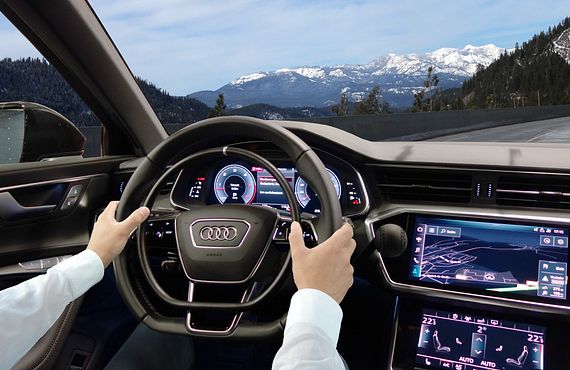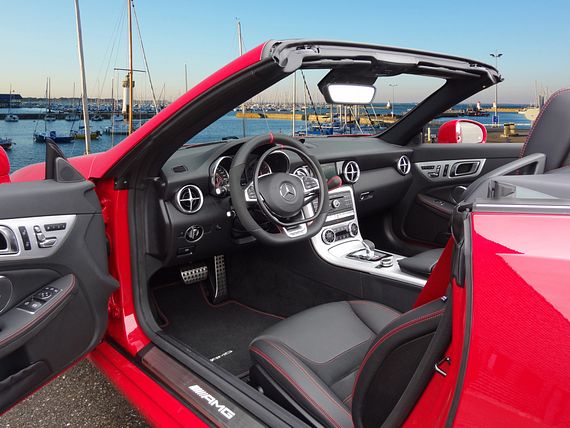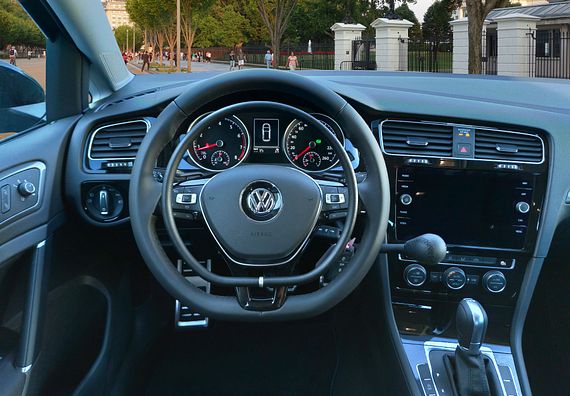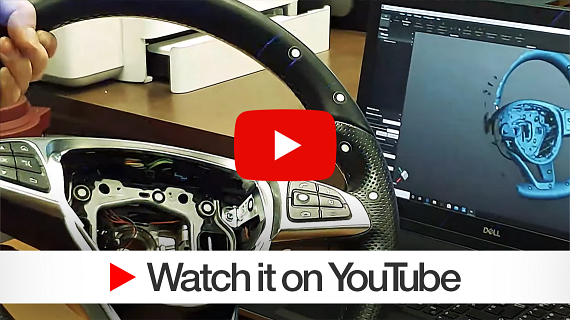Fast & economical manufacture
of complex parts
- What was needed: Special sliders with complex geometries
- Manufacturing method: Laser sintering
- Requirements: Optimised sliding properties, self-lubricating, durable
- Material: iglidur® I3
- Industry: Automotive
- Success from the collaboration: Cost-effective, fast manufacture of small volumes. Durable components with dry operation.
More about 3D printing at igus®
Problem
To manufacture accelerator rings for flattened steering wheels, the customer regularly needs special sliders that are joined together and slide "around the corner" on a metal ring. More than 200 elements are needed for each steering wheel. The only option for realising this movement is designing special sliders with a complex geometry involving numerous undercuts, making production with conventional manufacturing methods not only difficult, but very expensive. There is a 30-year guarantee on Kempf driving aids so the special sliders must be extremely durable and reliable. The components cannot be lubricated as they are permanently installed inside the accelerator ring's leather sleeve.Solution
The special sliders' complex structures and undercuts can be efficiently produced only with additive manufacturing. iglidur® I3, a high-performance polymer with optimised sliding properties, gave Kempf the ideal material from which to print the delicate elements. Laser sintered within 24 hours, the special sliders require no lubrication or maintenance to move smoothly around the corner. Despite the high order quantity (more than 10,000 units per order), the special sliders' great complexity made 3D printing even more cost-effective than injection moulding.
Driving with hands only: Darios, the digital accelerator ring on the steering wheel
Kempf insists on the highest quality for its products and offers its customers a 30-year guarantee on all its driving aids.KEMPF was established in 1955 by Hans Kempf, who had difficulty walking after suffering from polio. As an enthusiastic mechanic, he invented the accelerator ring in order to be able to drive with both hands on the steering wheel. By the time he died in 2002, he had retrofitted more than 100,000 vehicles.
The hand accelerator system Kempf developed is the only one on the market that adapts itself to the speed of the vehicle: at low speeds, the acceleration is gentle, progressive, and economical, while at high speeds, it is dynamic so that driving is safer and the driver can perform fast overtaking manoeuvres precisely and easily. All the usual steering wheel functions, such as adjustability, airbag, and horn, are retained. The pedals also remain functional – Darios can be deactivated by means of a switch so that other drivers can operate the vehicle in the usual manner.

Precise acceleration thanks to freely moving sleeve
In order to accelerate, the ring is pressed in the direction of the steering wheel. This requires only a very small amount of force (about three newtons). The stroke between idling and full acceleration is only about 18mm. When the steering wheel slides back to the straight-ahead position after a curve, the freely rotating sleeve enables precise acceleration when the vehicle comes out of the curve, regardless of the position of the steering wheel. Both hands can remain on the steering wheel when Darios is in operation, but the accelerator ring can also be operated with only one hand so that the hand brake can be operated with the other.With its fine leather cover, the accelerator ring fits in harmoniously with the interior of vehicles and the colour of the leather can be chosen if required. Since Darios 211 has been developed many cars now have flat steering wheels. This accelerator ring is flat, but also has a freely rotating sleeve. But how can a flat ring be fitted with a sliding cover?

More than 200 special sliders made of iglidur I3 ensure frictionless sliding
The new trend of equipping vehicles with flat instead of round steering wheels presented the Kempf engineers with a big challenge. For a flat steering wheel, a flat accelerator ring as flattened as the steering wheel is necessary both for technical and aesthetic reasons. The unobtrusive device which seems to be a natural part of the vehicle is, in reality, full of numerous complex details. Equipping a round accelerator ring with a sliding sleeve is comparatively easy. Covering a flat accelerator ring with a sleeve that rotates as freely as a round one calls for a technically complex solution.The product developers of Kempf found this solution in collaboration with the igus® 3D printing team. In the new Darios 211, the first flat accelerator ring in the world, additively manufactured components made of iglidur® I3 polymer which has optimised sliding characteristics are used. The flat accelerator ring has more than two hundred such elements that are flexibly joined together. They form a sliding ring around the flat metal core of the accelerator ring and thus enable seamless sliding of the sleeve. For this especially innovative solution, the company Kempf received the bronze manus award at the Hannover Trade Show in 2019.

Advantages of printed special sliders made of iglidur® I3
The engineers decided to 3D print the complex special sliders, due to the numerous undercuts made injection moulding very complicated and therefore expensive. Additive manufacturing imposes hardly any restrictions with regard to design rules and this makes manufacturing components with complex geometries economical.One of the most important reasons for choosing iglidur® I3 as the manufacturing material for the special slider was the solid lubricants it contains. No component maintenance is necessary, and component service life increases considerably because there is hardly any wear. iglidur I3® is an SLS powder that can be processed by all conventional laser sintering machines. The powder is melted layer-by-layer with a laser, enabling precise reproduction of fine structures. Depending on the size of the component, several thousand pieces can be manufactured in a printing process lasting about 24 hours. The customer profits not only from the high cost savings, but also from the fast manufacturing and delivery time. Another special feature that only laser sintering enables in this form is the printing of packaging for the filigree parts in the same printing process. The costs of packaging and the work it involves are avoided and there is no risk that individual components will be lost or damaged.
iglidur® I3 is the most frequently used 3D printing plastic in the igus® 3D printing service. In addition to its suitability for different sliding applications, it demonstrates its strengths as one of the best plastics on the market for 3D printed gears.
Further information on iglidur® I3
Other application examples for 3D printed components can be found here:
All customer applications at a glance
